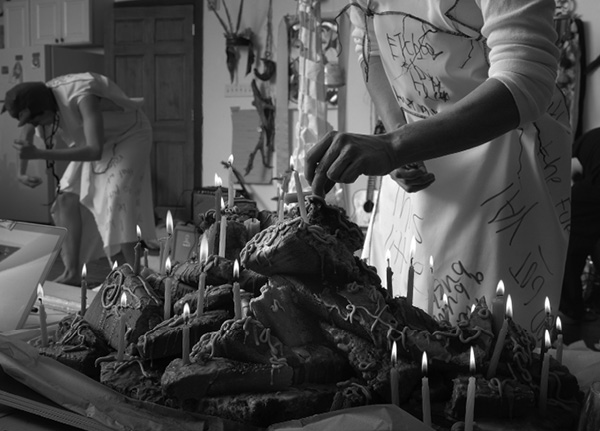
BEAST CONJURING
first performed on January 20, 2018
Paul McMahon’s Mothership, Woodstock, NY
performed once in 2018
NINA ISABELLE
Lorene Bouboushian, Brian McCorkle, Linda Mary Montano
Stone Ridge, NY
ninaisabelle.com
BEAST CONJURING
NINA ISABELLE
The “Beast Conjuring” performance intended to conjure and kill the sea beast from the Book of Revelation. A group of artists and performers were invited to simultaneously interweave their own processes and intentions as a way to generate energies that might be focused toward the common goal of beast conjuring. Together, the group worked to build and maximize the physical, sensory, and psychic spaces that bind the internal and external dimensions of awareness through performative modes of sound making, movement, object construction, and ceremonial-like gestures. This process became an inquiry into how a metaphoric conjure-and-kill scenario might translate or become useful in a literal dimension where such things are less possible-seeming.
“Beast Conjuring” was performed within an installation including ten hand-fabricated crowns, ten cedar root horns dug from local woods, hand-painted imagery of the seven-headed ten-horned beast, a suspended hand-sewn white linen angel, a reconstructed domestic scene from the home of an ex-evangelical, and a giant edible Whore of Babylon cake as bait. Lorene Bouboushian read personal text and improvised sound and movement, Linda Mary Montano performed a holy water blessing as Chicken Linda, Brian McCorkle produced sound using a saxophone and his specially designed Beast Box (a noise machine built with raspberry-pi based software that casts neural nets for soul retrieval), Jennifer Zackin engaged in a task-based performance to weave a beast trapping vortex, Ever Peacock and I performed an acoustic rendition of Larry Norman’s You’ve been Left Behind thirteen consecutive times, all awash in Miles Pflanz’s video remake of the 2014 American Christian apocalyptic thriller film Left Behind (based on the bestselling novels by Tim Lahaye and Jerry B. Jenkins) that reframes durational performance art as post-apocalyptic living.
It’s difficult to gauge the effectiveness of a performance conglomerate like “Beast Conjuring” due to its potential to be made to mean multiple things by participants, observers, and the ripples of their combined experiences and energies. At the same time, the ability of a situation to evade meaning is exciting. No literal beast popped out of the floor, no politicians were struck dead, and there weren’t any recognizable or even loosely associated repercussive events of cosmic significance, but the usefulness and appeal of such a process seems to unfurl over time in a circular and translucent way that generates unanswerable questions and hints at the possibilities and potential of less realistic thinking and doing.